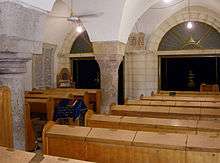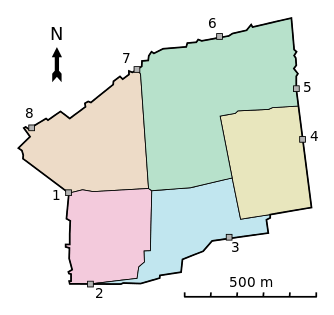Ramban Synagogue
The Ramban Synagogue (Hebrew: בית כנסת הרמב"ן), is the second oldest active synagogue in the Old City of Jerusalem. It was founded by the scholar and rabbi Nachmanides (also known as Ramban) in 1267,[2] to serve the local Jewish community, which expanded because of the synagogue's presence.[3][4]
| Ramban Synagogue | |
|---|---|
 Interior, 2006 | |
| Religion | |
| Affiliation | Orthodox Judaism |
| Rite | Nusach Ashkenaz |
| Leadership | Rabbi Avigdor Nebenzahl[1] |
| Status | Active |
| Location | |
| Location | ha-Yehudim Street Old City of Jerusalem |
Today there are two Ramban Synagogues in Jerusalem. The ancient synagogue described in this article stands in the Old City. A second Ramban Synagogue was established after 1948 and rebuilt in 2005. It is located at 4 Amatsya Street in the Katamon neighbourhood of Jerusalem.[5]
Features
The foundation of the building comprises vaults resting on Romanesque and Byzantine capitals. Along with the fact that there are no Gothic or Islamic architectural features, this suggests that the original building predates the Crusader period.
The synagogue is located three meters below street level, to comply with Muslim restrictions for Dhimmi houses of prayer not to be higher than mosques.[6]
History
13th century
| Old Yishuv |
|---|
 |
| Key events |
|
| Key figures |
|
| Economy |
| Philanthropy |
| Communities |
| Synagogues |
| Related articles |
After the Disputation of Barcelona, Nachmanides was exiled from Aragon, and in 1267 he made aliyah to the Land of Israel. In an alleged letter[7] to his son, he described the Jewish community of Jerusalem devastated by the Khwarezmian Tatars:
Many are its forsaken places, and great is the desecration. The more sacred the place, the greater the devastation it has suffered. Jerusalem is the most desolate place of all. ... There are ten men who meet on the Sabbaths they hold services at their home. ... Even in its destruction, it is an exceedingly good land.[2]
Seventy two years old, he undertook the effort to rebuild the Jewish community and chose a ruined house on Mount Zion to reconstruct it as a synagogue. A number of Jews moved to Jerusalem after hearing of Nachmanides' arrival. The Torah scrolls that were evacuated to Shechem before the Mongol invasion were returned. In three weeks, for Rosh Hashanah, the synagogue was ready for use.
16th century

In 1586, the synagogue was closed under the order of the Turkish governor of Jerusalem.[6] Subsequently, the Sephardi community established their center in the adjacent place, where the academy belonging to the tanna Yochanan ben Zakai was said to have stood during the Second Temple period. Today the Yochanan ben Zakai Synagogue stands there.
The Nachmanides Synagogue shared a wall with the Sidna Umar Mosque and was described as similar in design. Ottoman authorities issued a Firman to lock the synagogue door due to local complaints of 'noisy ceremonies' and further legal disputes were prohibited after the 1598 confiscation.[8]
19th century
In 1835, the leaders of the community managed to obtain a permission from the Ottoman authorities for the renovation of the synagogues, which were unified into a single unit.
20th century
Over the years, the building has been the home to the Sephardi community, was converted into a mosque after being confiscated by a Mufti, and was used as a flour mill and a cheese factory. Today it is used by the Ashkenazi community.
After the 1948 Arab-Israeli War, the building was destroyed by the Arab Legion. As a result of the 1967 Six-Day War, Jews regained access to the property, and 700 years after Nachmanides revived the ancient building, the synagogue was reopened.
See also
- Oldest synagogues in the world
- Cave of the Ramban
References
- "Staff - Yeshivat HaKotel". Hakotel.org.il. Retrieved 2016-08-23.
- The Ramban Synagogue; Hope Amidst Despair by Larry Domnitch (The Jewish Magazine)
- "Ramban Synagogue – Oldest in-use synagogue in Jerusalem". Attractions-in-israel.com. 2011-10-18. Retrieved 2016-08-23.
- Domnitch, Larry (2005-06-01). "How Nachmanides Rebuilt Jerusalem". Aish.com. Retrieved 2016-08-23.
- By Jonathan Lis7 hours ago This is a primium article (2014-12-09). "Why Jerusalem Has Two 'Ramban Synagogues' - Religion & Holy Land". Haaretz. Retrieved 2016-08-23.
- Sephardic Synagogues of Old Jerusalem
- Norman Roth (8 April 2014). "Synagogues". Medieval Jewish Civilization: An Encyclopedia. Routledge. p. 622. ISBN 978-1-136-77155-2.
- Stillman, Norman A. (5739-1979) The Jews of Arab Lands: a history and source book. Philadelphia: The Jewish Publication Society of America. p. 92 and pp. 301-302. ISBN 0-8276-0116-6.
External links
| Wikimedia Commons has media related to Ramban Synagogue. |
- Synagogues of the World. Jerusalem (Jewish Virtual Library)
- Moshe ben Nahman RaMBaN Synagogue (sephardiccouncil.org)
- How Nachmanides Rebuilt Jerusalem (aish.com)
